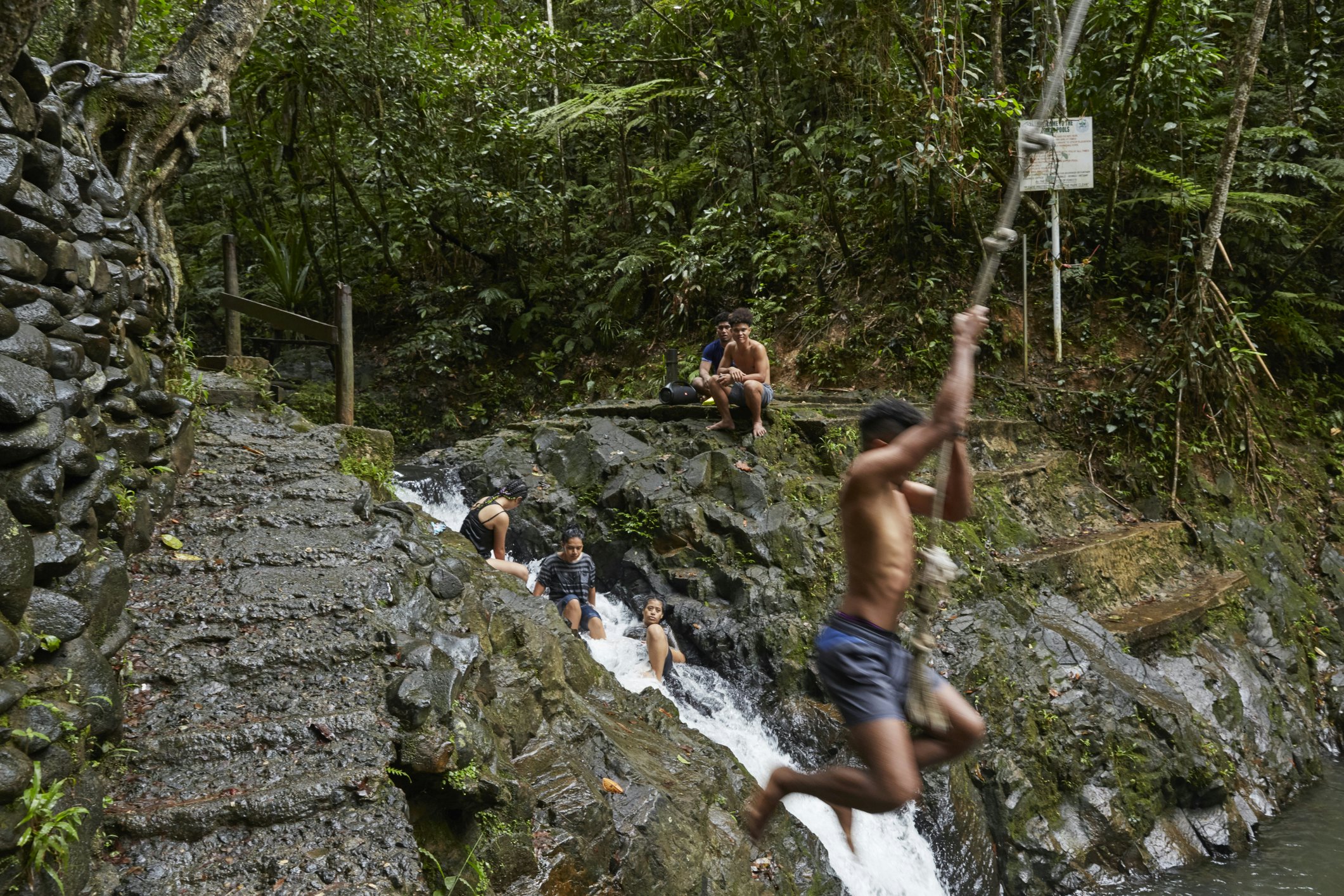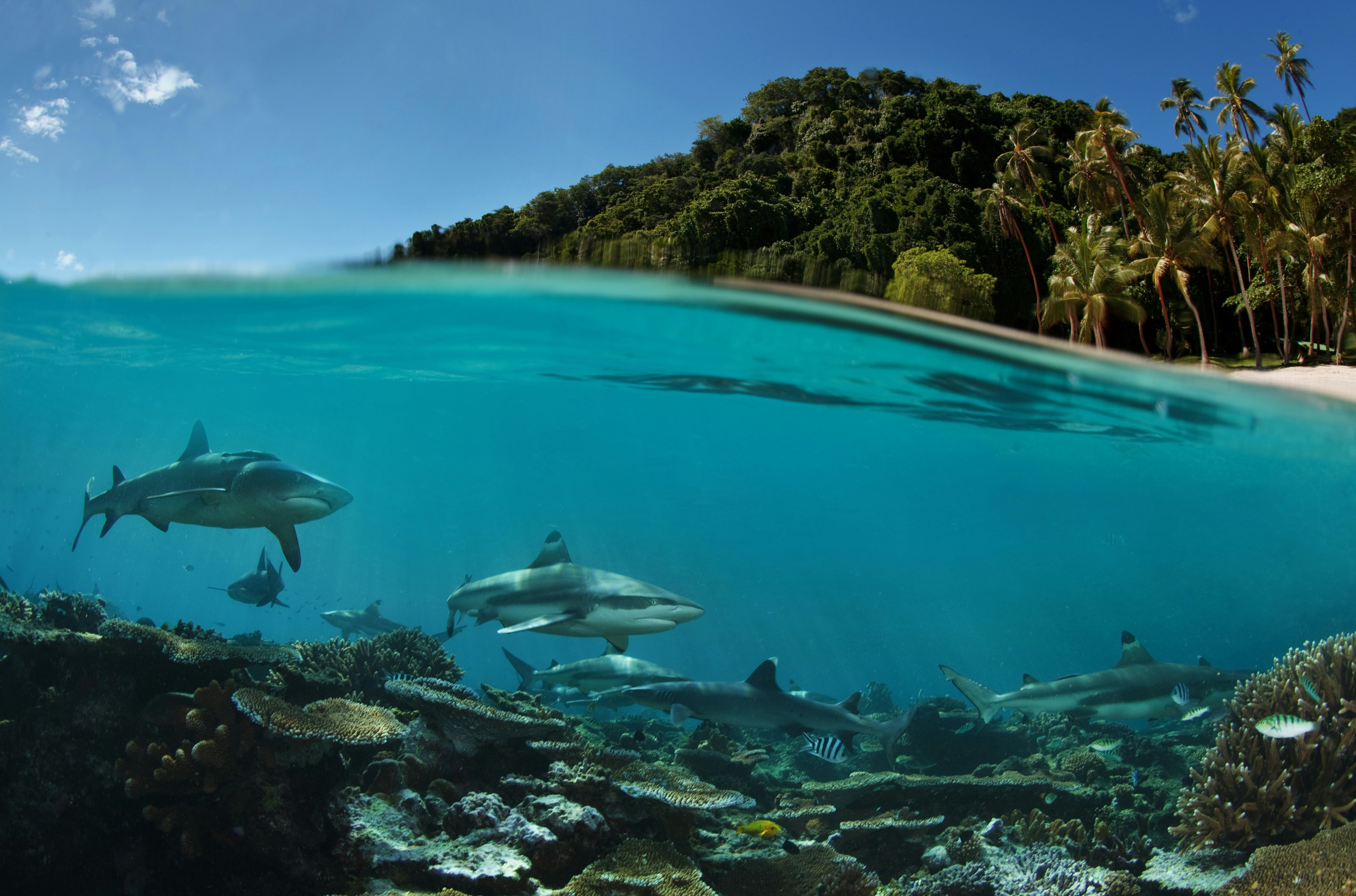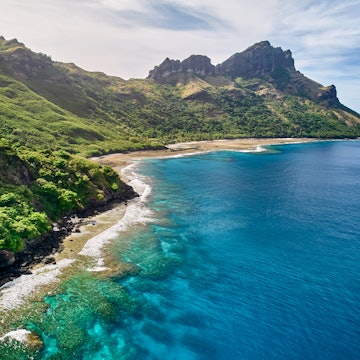
Don’t leave Fiji without visiting these national parks and marine sanctuaries

Dec 9, 2021 • 6 min read

Bouma National Park has trails catering to hikers of all levels – and to families, too ©Don Mammoser/Shutterstock
From cloud-topped mountain peaks to colorful coral reefs, Fiji’s borders encompass 333 islands as well as the waters that surround them.
Travelers who prefer to spend most of their time outside will find few better places in the world to explore. Hike along rainforest trails to cascades, run full speed down a sand dune, blow bubbles alongside tens of sharks – and get ready for a trip where you won’t dare be bored.
Fiji is home to four national parks and over 100 marine sanctuaries where wildlife is protected. While a nature-bound adventure can usually be found steps away from your accommodation, these are the national parks and marine sanctuaries worth going to extra effort to see.

Bouma National Heritage Park – Taveuni
Bouma National Heritage Park on the lush island of Taveuni is where you can explore tropical rainforests with waterfalls and villages hidden among its trees. Many of its best cascades are easily accessible, like the first of the trio of Tavoro Falls, making it one of the best national parks in Fiji for families. On the Lavena Coastal Walk, you’ll follow a trail along Taveuni’s wild coastline, crossing beaches that jump from white to black sand, tropical flowers and fruit trees, and a swimming hole with a hidden waterfall.
If you crave trails that will challenge you, climb Taveuni’s volcanic crater to Des Voeux Peak and look out over Lake Tagimoucia. The area is home to the tagimoucia, Fiji’s national flower that can be seen on the country’s $50 banknote. The crimson-and-white blossom grows solely in this region of Taveuni.
Visiting Bouma National Heritage Park
Entrance into the park costs FJD$36 ($17) per person, paid on arrival into Bouma or Lavena village. All major resorts and accommodations on Taveuni can help arrange guided tours of the park, and it’s doable as a day trip. Budget one day for the Lavena Coastal Walk and a second for Tavoro Trail.
Sigatoka Sand Dunes – Viti Levu
Sigatoka Sand Dunes National Park is one of the most historically significant national parks in the country, as archeologists have uncovered pottery and human remains dating back over 2500 years. The park hosts a visitor center with a handful of relics and information about how the sand dunes came to be. A short trail through a mahogany forest leads to the dunes themselves, which can look in overcast skies like mounds of gray ash, or bear a golden tint in full sun. Carve out a spot for a picnic, go for a swim (if seas are calm) or take the challenge of sprinting down a dune without care of consequence.
If it’s crowded, walk down the beach towards the Sigatoka River to find a swath of sand to yourself – though you might see a surfer or two making their way over the crest with a board underarm.
Visiting Sigatoka Sand Dunes National Park
Sigatoka Sand Dunes National Park is an easy day trip from Nadi or Suva, and a convenient road trip stop if driving along the Coral Coast. Entrance to the park costs FJD$10 ($5.70) per adult and FJD$5 ($2.35) per child. The visitor center is open from 8am to 5pm daily.

Colo-I-Suva Forest Park – Viti Levu
You don’t have to venture far from Fiji’s capital city to get lost in a jungle. Just 12 km (7mi) outside of Suva’s city center is Colo-I-Suva Forest Park, a popular place for Suva residents to spend their holidays and weekends. The first mile of the trail into the park is well kept – it was redone in 2018 for the British royal visit – and leads to a tranquil swimming hole. Jungle vines and tree roots encroach into the trail further along – but persistence is rewarded by creek walks, rope swings, uncrowded swimming areas, picnic benches and waterfalls that range from barely a trickle to modest cascades.
Visiting Colo-I-Suva Forest Reserve
For non-Fijian citizens, the entrance fee into Colo-I-Suva is FJD$5 ($2.35) per person; the front gate is open from 8:30am to 4pm daily. It’s wise to take a photo of the park map at the park trail entrance as trails are not well marked and phone reception can be spotty. Muggings have been known to happen here, so leave valuables behind.
Koroyanitu National Heritage Park – Viti Levu
With grasslands, waterfalls, hiking trails that range from leisurely to downright grueling, jagged peaks and welcoming villages, Koroyanitu National Heritage Park is a paradise for travelers who have a penchant for adventure. Trek to the top of Mount Batilamu for views of the Mamanuca and Yasawa Islands. Pack your bathing suit to enjoy a dip in one (or many) of the site’s waterfall-fed natural pools.
Residents of the six villages within park grounds are custodians of the area, and often welcome travelers to have a home-cooked lunch for a small fee. For a true Fijian experience, stay the night and pack along a bundle of yaqona (kava) to share with the villagers, who will pour out servings of the mud-colored relaxant after a long day of trekking.
Visiting Koroyanitu National Heritage Park
The visitor center in Abaca is technically open from 8am to 5pm Monday to Saturday and 8am to 10am and 12pm to 5pm on Sunday, though you might not always spot someone at the desk. Entrance costs FJD$25 ($11.80) per person. Trails aside from the one to Mount Batilamu are best explored with a guide (FJD$20-50 per person depending on the hike), as many are unsigned. There are barebones huts in the park for campers (FJD$40 per person).

Shark Reef Marine Reserve – Beqa Lagoon
Shark Reef Marine Reserve was founded in 2004 to protect eight species of sharks, from small species like blacktip and whitetip reef sharks to giant bull sharks and tiger sharks. A visit to the reserve is one you won’t forget, as you drift down to the seabed and watch as tens of sharks circle above – all without a cage. Just be sure to stay still.
This sanctuary was made possible through tourism, as the village of Galoa receives money from the shark-dive operator to protect the sanctuary from any form of fishing. Hundreds of other fish species have also taken shelter in these waters, which teem with marine life.
Visiting Shark Reef Marine Reserve
Shark Reef Marine Reserve is in Beqa Lagoon, accessed from Pacific Harbour. Dives are organized through Beqa Adventure Divers and cost FJD$325 ($153) for a two-tank dive plus FJD$50 ($23.50) entrance levy.

Namena Marine Reserve – Vanua Levu
Namena Marine Reserve off Vanua Levu is Fiji’s largest marine sanctuary, protected by multiple villages in the region. Underwater, snorkelers and divers discover soft corals that span the rainbow, hosting sea turtles, crabs, octopi, eels, anemones, and over 1000 species of fish. And while the reef is mesmerizing during a dive, be sure to look into the blue as dolphins, whales, sharks, tuna, and other pelagic marine life are often seen cruising through. Some of the coral bommies are found in shallower waters, making this a perfect place to explore for divers and snorkelers alike.
Visiting Namena Marine Reserve
Namena Marine Reserve is best accessed through dive resorts and operators in Savusavu on Vanua Levu. Jean-Michel Cousteau Resort, Namale Resort and Namena Divers at Koro Sun Resort offer trips to the reserve.
You might also like:
The A-to-Z of Fiji: 26 reasons to visit the island paradise
How to get around Fiji whatever your budget
Do I need a visa to visit Fiji?













